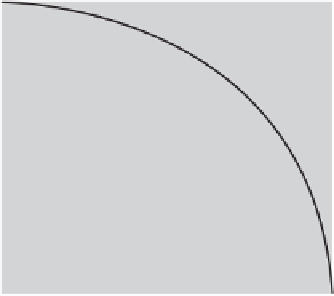Biomedical Engineering Reference
In-Depth Information
Figure 6.3
Alkane molecules (open rectangles) align with surfactant at the interface and produce a
template for crystal nucleation (adapted from Awad and Sato, 2002).
(a)
(b)
(c)
Figure 6.4
Proposed structures of (a) liquid nanoemulsions and SLN from TAG in the (b)
crystal form (adapted from Bunjes
et al
., 2007). Straight lines show the alignment of selected molecular
backbones in the crystal lattice. The
α
and (c)
β
α
crystals are aligned near the droplet surface and the more disordered
structure in the core. The
β
crystals are aligned in lamellae as shown. (Highly schematic and not to scale.)
The second effect of emulsification on fat crystallization is thermodynamic in origin
and arises from the elevation in internal droplet pressure due to the curvature of the
surface. The lipid is pressurized by the interfacial tension and thus the formation of the
more dense crystal phase is favored. This effect is only really important for very small
particles (<100 nm). For example, Higami and co-workers (2003) showed that the melting
temperature of very fine trilaurin droplets (
-polymorph, bulk melting point 46.7 °C) was
reduced to as low as 26.5 °C. In some very fine particles, the different lamellae of the lipid
may have distinct melting points. For example, Bunjes and co-workers (2000) showed
that as the particle size of TAG droplets was decreased the melting range broadened and
in DSC showed a number of distinct peaks, which were attributed to the melting of distinct
layers of the crystal.
β







Search WWH ::

Custom Search